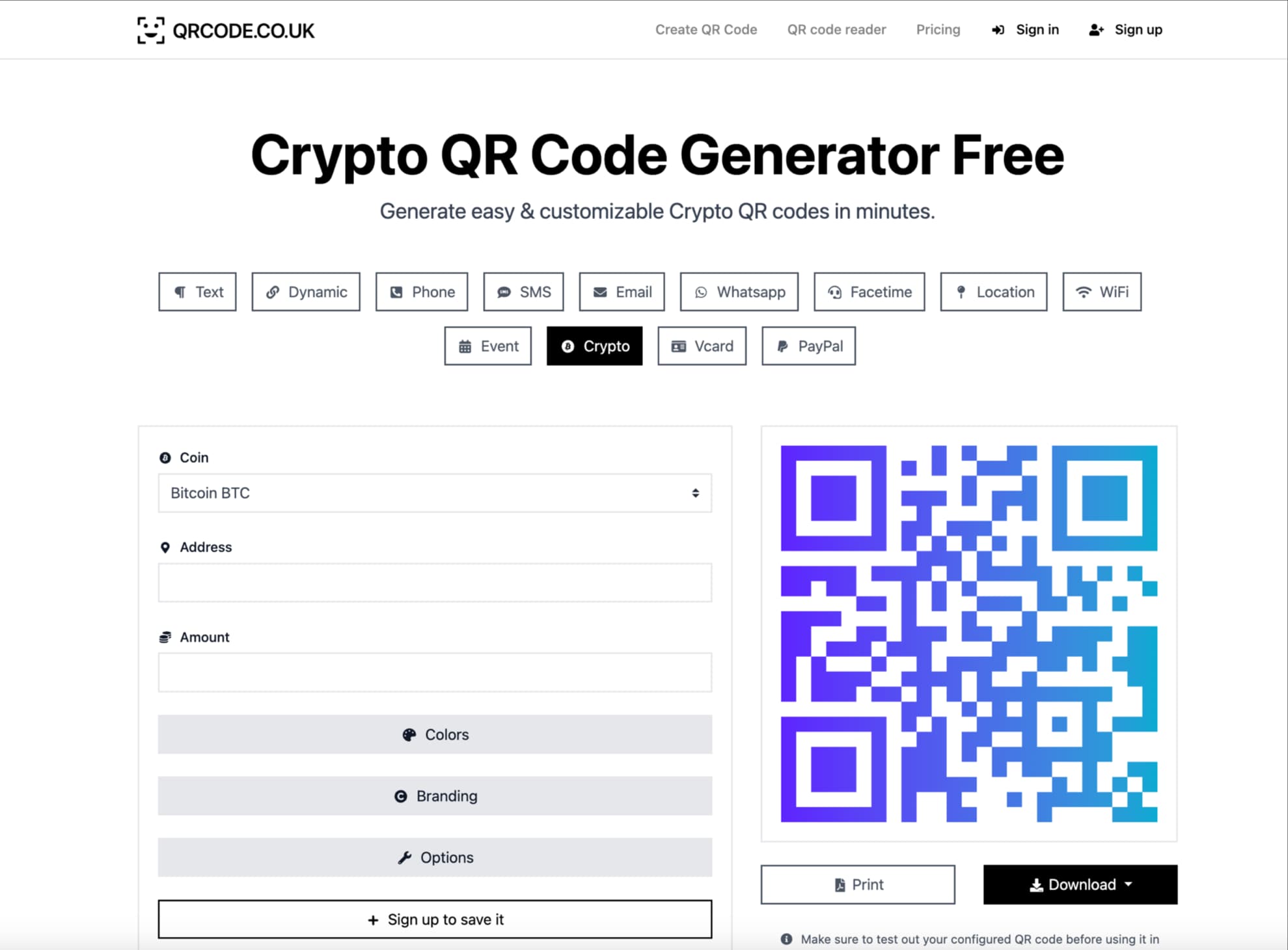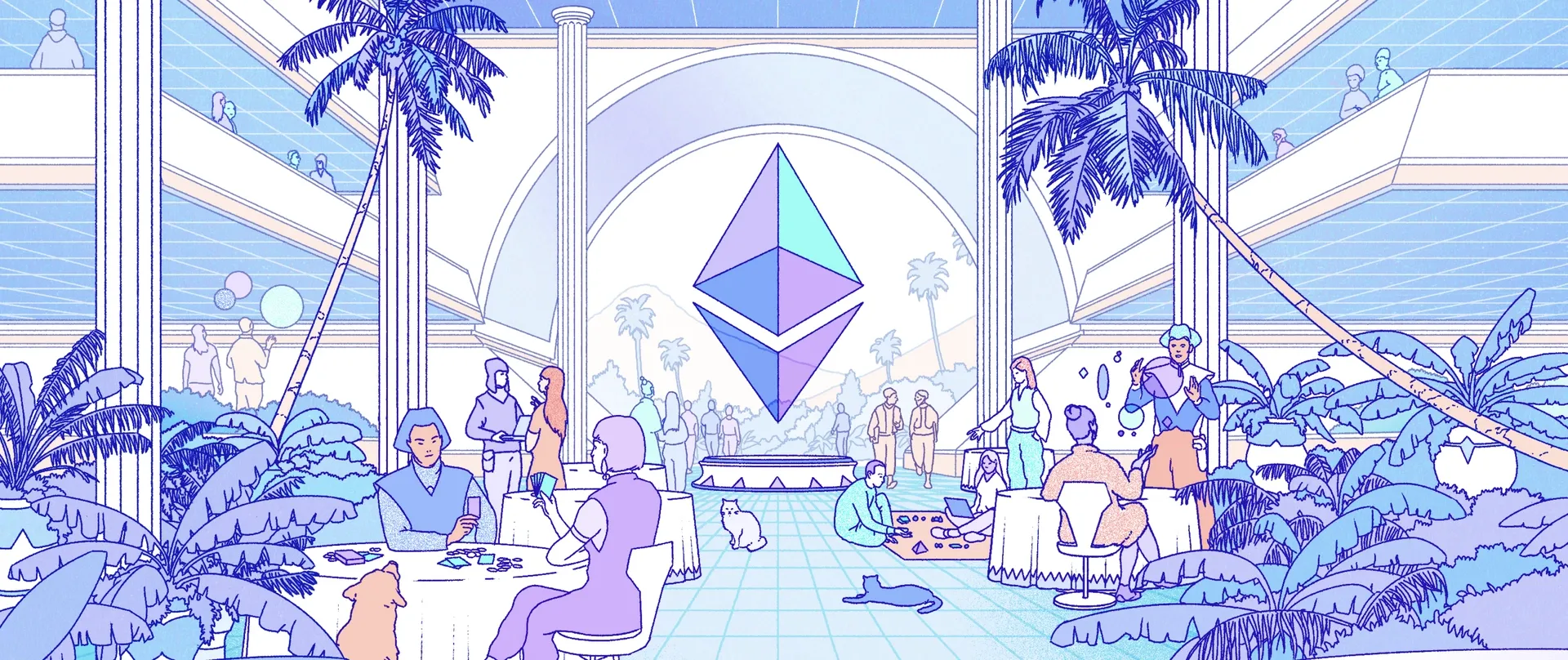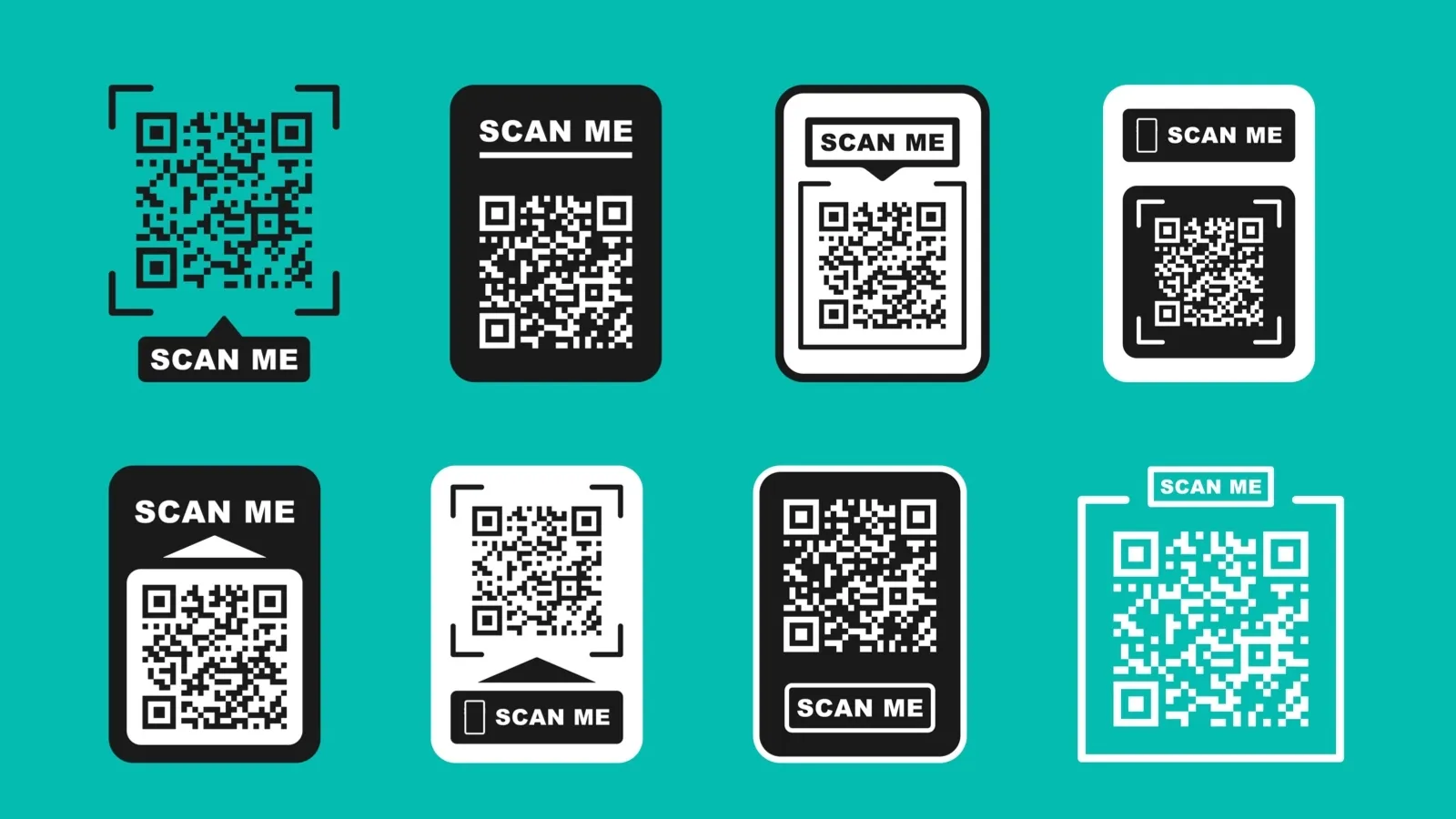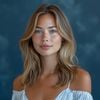Ethereum QR Code Generator: How to create a QR Code to Send Ethereum?
Brief Overview of Ethereum

Ethereum is a decentralized, open-source blockchain platform that enables the creation of smart contracts and decentralized applications (dApps). With its native cryptocurrency, Ether (ETH), Ethereum has become one of the most popular blockchain platforms in the world.
Importance of QR Codes for Seamless Transactions
Quick Response (QR) codes have become an essential tool for streamlining transactions in various industries, including cryptocurrency. They allow for easy, accurate, and fast information sharing, making transactions more convenient and secure.
Purpose of the Blog
In this blog post, we will guide you through the process of creating an Ethereum QR code, which will help you send and receive Ether more efficiently.
How to Generate an Ethereum QR Code
QRCode.co.uk Ethereum Crypto QR Code Generator
The simple way to generating Ethereum QR codes:
- Online generators: Websites that generate QR codes like qrcode.co.uk for Ethereum addresses
- Mobile applications: Apps designed specifically for managing cryptocurrencies, which often include a built-in QR code generator.
- Desktop applications: Some desktop wallet applications also offer QR code generation features.
Steps to Create an Ethereum QR Code with QRCode.co.uk
To create an Ethereum QR code, follow these steps:
First you need to open our qr code generator tool:

- Enter your Ethereum public address: Input your Ethereum address into the our crypto QR code generator.
- Set additional options (if applicable): Some generators allow for customization, such as setting the requested amount of Ether or adding a label to the code.
- Generate the QR code: Click on the "Generate" button to create the QR code.
- Save and/or print the QR code image: Download the generated QR code image or print it for future use.
Tips for Ensuring Security and Privacy

When generating a QR code, always ensure that you use a reputable generator and never share your private key. Additionally, avoid using public computers or devicesto generate QR codes, as they may be compromised.
How to Scan an Ethereum QR Code
Scanning QR Codes with Mobile Devices
Mobile devices offer various options for scanning QR codes:
- Built-in camera apps: Many smartphones come with a built-in QR code scanner in the camera app, allowing you to scan codes by simply pointing the camera at the QR code.
- QRCode.co.uk QR Code Reader: You can also scan qr codes with qrcode.co.uk qr reader.
Confirming the Scanned Address
After scanning the Ethereum QR code, make sure to verify that the displayed wallet address matches the intended recipient's address. This will ensure that you are sending funds to the correct destination.
Benefits of Using QR Codes for Ethereum Transactions

Improved Security
QR codes reduce the risk of human error when entering wallet addresses, minimizing the chance of sending funds to the wrong address.
Reduced Chances of Human Error
As mentioned above, QR codes make it easier to share and input wallet addresses accurately, reducing the likelihood of errors.
Faster and More Convenient Transactions
Scanning a QR code is significantly faster than manually typing an address, allowing for quicker transactions.
Easy Sharing of Public Addresses
QR codes can be easily shared through various channels, such as email, social media, or printed materials, making it simple for others to send funds to your Ethereum address.
Best Practices for Ethereum QR Codes
Double-Checking Generated QR Codes
After generating a QR code, it's a good idea to scan it with a QR code reader to confirm that it correctly encodes your Ethereum address.
Securing QR Code Images
Treat your QR code images as sensitive information. Store them securely, and avoid sharing them on unsecured platforms or with untrusted parties.
Educating Others about QR Code Safety
Spread awareness about the importance of QR code safety and the best practices for using QR codes in cryptocurrency transactions.
The Future of QR Codes and Cryptocurrency Transactions

As the use of cryptocurrencies continues to grow, it's likely that QR codes will become even more prevalent in the industry. Innovations in both QR code technology and the Ethereum platform may lead to new, exciting ways to use QR codes for cryptocurrency transactions. By staying informed and adopting best practices, you can ensure that you're prepared to take advantage of these developments and make the most of your Ethereum transactions. X. Troubleshooting Common Issues with Ethereum QR Codes
QR Code is Not Scanning
If you're having trouble scanning an Ethereum QR code, try the following:
- Ensure that the QR code image is clear and not distorted.
- Check if the scanner app or software is compatible with Ethereum QR codes.
- Make sure there is sufficient lighting when scanning the QR code.
- Clean your device's camera lens and ensure there are no obstructions.
- Try using a different QR code scanning app or software.
Incorrect Address Displayed After Scanning
If an incorrect Ethereum address is displayed after scanning a QR code:
- Double-check the QR code to ensure it's the correct one for the intended Ethereum address.
- Verify that the QR code generator used to create the code is reputable and hasn't introduced any errors.
- Test the QR code with a different scanning app or software to see if the issue persists.
Lost or Damaged QR Code
If you lose or damage a printed Ethereum QR code:
- Regenerate the QR code using the same Ethereum address and a reputable generator.
- Store a backup of the QR code image in a secure location to prevent future loss.
- Consider using a more durable medium, such as a metal or plastic card, for printing the QR code to avoid damage.
Staying Up to Date with Ethereum and QR Code Developments
To make the most of your Ethereum transactions and stay informed about the latest advancements in QR code technology, consider the following:
- Follow reputable news sources and blogs related to Ethereum and blockchain technology.
- Participate in forums and online communities discussing Ethereum and cryptocurrencies.
- Attend conferences, webinars, and workshops focused on cryptocurrencies and blockchain technology.
- Subscribe to newsletters from reputable organizations and thought leaders in the cryptocurrency space.
- Experiment with new tools and technologies as they become available, always ensuring that they are secure and reliable.
By staying informed and engaged with the Ethereum and QR code communities, you can make the most of your Ethereum transactions and contribute to the ongoing development and improvement of these technologies.
Alternatives to QR Codes for Ethereum Transactions
While QR codes offer numerous benefits for Ethereum transactions, there are alternative methods available for those who prefer a different approach or need additional options.
Copy and Paste Addresses
The most straightforward alternative to using QR codes is copying and pasting Ethereum addresses. While this method may be more prone to human error, it can still be effective if you double-check the address before sending a transaction.
Near Field Communication (NFC)
NFC technology enables devices to exchange information by simply being in close proximity to each other. Some cryptocurrency wallets support NFC, allowing for seamless Ethereum transactions without the need for QR codes. To use NFC, both the sender's and recipient's devices must be NFC-enabled.
Payment Protocols
Payment protocols, such as the Ethereum Request for Comment (ERC) standards, can facilitate transactions by specifying a set of rules for smart contracts. These protocols can help streamline the transaction process and reduce the need for manually entering wallet addresses.
Integrated Wallet Services
Some platforms and services offer integrated Ethereum wallet solutions, allowing users to send and receive Ether within the platform itself. This can eliminate the need to share wallet addresses, as transactions are handled internally.
Embracing the Future of Ethereum Transactions
As technology continues to evolve, so too will the ways we conduct Ethereum transactions. Whether through QR codes, NFC, or other emerging technologies, staying informed and adaptable will help ensure you are prepared to make the most of your cryptocurrency transactions.
By understanding and embracing these advancements, you can improve your user experience and contribute to the development of more efficient, secure, and convenient methods for sending and receiving Ethereum. Ultimately, the future of Ethereum transactions lies in our ability to innovate, adapt, and work together to build a more robust and accessible financial ecosystem.
What is a QR Code?

Definition and History of QR Codes
QR codes are two-dimensional barcodes that can store a significant amount of data. They were first developed in 1994 by the Japanese company Denso Wave for tracking automotive components. Today, QR codes are widely used for various purposes, from product packaging to mobile payments.
Common Use Cases for QR Codes
QR codes have found applications in many industries, including retail, marketing, logistics, and payments. They are often used for:
- Product tracking and inventory management
- Promotions and marketing campaigns
- Contactless payments
- Mobile app integration
Frequently Asked Questions About Ethereum Crypto QR Code
To help you better understand Ethereum QR codes and their role in cryptocurrency transactions, here are some commonly asked questions and their answers:
Can I include additional transaction information in an Ethereum QR code?
Yes, some QR code generators allow you to include additional transaction details, such as the transaction amount or a short message. This can be useful for providing context or streamlining the payment process. However, ensure that the recipient's wallet or scanner app supports these additional details.
Can I use the same QR code for multiple transactions?
Yes, you can use the same Ethereum QR code for multiple transactions, as it simply represents your public wallet address. However, for privacy and security reasons, it is recommended to use a new address for each transaction, especially if you're conducting business or dealing with sensitive transactions.
Can I reverse a transaction made using a QR code?
No, once a transaction is made on the Ethereum network, it cannot be reversed. This is why it's crucial to double-check the scanned wallet address before sending any funds.
How can I protect my Ethereum QR code from being tampered with?
To protect your Ethereum QR code from tampering, store it securely and avoid sharing it on unsecured platforms or with untrusted parties. Additionally, use reputable QR code generators and scanners to minimize the risk of errors or malicious modifications.
Are QR codes the only option for transferring Ethereum?
No, QR codes are just one of many options for transferring Ethereum. Alternatives include copying and pasting wallet addresses, using NFC technology, leveraging payment protocols, and utilizing integrated wallet services.
By understanding the role of Ethereum QR codes in cryptocurrency transactions, you can make informed decisions about the best methods for sending and receiving Ether, ensuring a seamless and secure experience as the world of digital currencies continues to evolve.
You can also create dynamic ethereum qr code via qrcode.co.uk. If you don't know what are the differences between static and dynamic qr codes please look at our related blog post.

